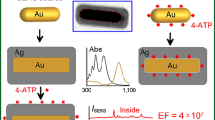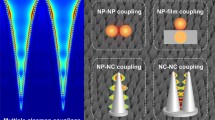Abstract
The controlled tuning of interparticle distance at the nanoscale level is a major challenge for nanofabrication of surface-enhanced Raman scattering (SERS) active clusters and their application to molecular sensing. In fact, the geometrical properties of the narrow gaps between nanoparticles play a key role in determining the local field enhancement (and therefore, the SERS enhancement factor) and the spatial enhancement distribution in the gap region. Besides, very short interparticle distances may block the access of the analyte to the hot zone. In this paper, we report the synthesis of silver colloid NP clusters with interparticle distances fine tuned in the ≤2 nm range, by exploiting the chemical properties of linear α,ω-aliphatic diamines as molecular linkers with varying chain length. The bifunctional diamines also form intermolecular cavities within their self-assembled monolayers, suitable to host molecular analytes for nanosensing applications, as evidenced by SERS detection of organochlorine insecticides at the trace level. In this regard, the extension of the aliphatic chain played a crucial role in determining the SAM conformation and thus the final sensitivity of the functionalized SERS substrate.













Similar content being viewed by others
References
Aroca R (2006) Surface-enhanced vibrational spectroscopy. Wiley, Chichester
Haynes CL, McFarland AD, Van Duyne RP (2005) Surface-enhanced Raman spectroscopy. Anal Chem 77:338A–346A
Moskovits M (1985) Surface-enhanced spectroscopy. Rev Mod Phys 57:783–826
Shalaev VM (1996) Electromagnetic properties of small-particle composites. Phys Rep Rev 272:61–137
Novotny L, Hecht B (2006) Principles of nano-optics. Cambridge Unversity Press, New York
Xu HX, Bjerneld EJ, Kall M, Borjesson L (1999) Spectroscopy of single hemoglobin molecules by surface enhanced Raman scattering. Phys Rev Lett 83:4357–4360
Schuck PJ, Fromm DP, Sundaramurthy A, Kino GS, Moerner WE (2005) Improving the mismatch between light and nanoscale objects with gold bowtie nanoantennas. Phys Rev Lett 94:017402
Muhlschlegel P, Eisler HJ, Martin OJF, Hecht B, Pohl DW (2005) Resonant optical antennas. Science 308:1607–1609
Muskens OL, Giannini V, Sanchez-Gil JA, Rivas JG (2007) Strong enhancement of the radiative decay rate of emitters by single plasmonic nanoantennas. Nano Lett 7:2871–2875
Farahani JN, Pohl DW, Eisler HJ, Hecht B (2005) Single quantum dot coupled to a scanning optical antenna: a tunable superemitter. Phys Rev Lett 95:017402
Sonnichsen C, Reinhard BM, Liphardt J, Alivisatos AP (2005) A molecular ruler based on plasmon coupling of single gold and silver nanoparticles. Nat Biotechnol 23:741–745
McFarland AD, Van Duyne RP (2003) Single silver nanoparticles as real-time optical sensors with zeptomole sensitivity. Nano Lett 3:1057–1062
Aldeanueva-Potel P, Faoucher E, Alvarez-Puebla RA, Liz-Marzan LM, Brust M (2009) Recyclable molecular trapping and SERS detection in silver-loaded agarose gels with dynamic hot spots. Anal Chem 81:9233–9238
Rodriguez-Lorenzo L, Alvarez-Puebla RA, Pastoriza-Santos I, Mazzucco S, Stephan O, Kociak M, Liz-Marzan LM, de Abajo FJG (2009) Zeptomol detection through controlled ultrasensitive surface-enhanced Raman scattering. J Am Chem Soc 131:4616–4618
Muskens OL, Giannini V, Sanchez-Gil JA, Rivas JG (2007) Optical scattering resonances of single and coupled dimer plasmonic nanoantennas. Opt Express 15:17736–17746
Olk P, Renger J, Wenzel MT, Eng LM (2008) Distance dependent spectral tuning of two coupled metal nanoparticles. Nano Lett 8:1174–1178
Anderson DJ, Moskovits M (2006) A SERS-active system based on silver nanoparticles tethered to a deposited silver film. J Phys Chem B 110:13722–13727
Lee SJ, Morrill AR, Moskovits M (2006) Hot spots in silver nanowire bundles for surface-enhanced Raman spectroscopy. J Am Chem Soc 128:2200–2201
Braun GB, Lee SJ, Laurence T, Fera N, Fabris L, Bazan GC, Moskovits M, Reich NO (2009) Generalized approach to SERS-active nanomaterials via controlled nanoparticle linking, polymer encapsulation, and small-molecule infusion. J Phys Chem C 113:13622–13629
Guerrini L, Garcia-Ramos JV, Domingo C, Sanchez-Cortes S (2008) Building highly selective hot spots in Ag nanoparticles using bifunctional viologens: Application to the SERS detection of PAHs. J Phys Chem C 112:7527–7530
Vlckova B, Moskovits M, Pavel I, Siskova K, Sladkova M, Slouf M (2008) Single-molecule surface-enhanced Raman spectroscopy from a molecularly-bridged silver nanoparticle dimer. Chem Phys Lett 455:131–134
Pavel I, McCarney E, Elkhaled A, Morrill A, Plaxco K, Moskovits M (2008) Label-free SERS detection of small proteins modified to act as bifunctional linkers. J Phys Chem C 112:4880–4883
Guerrini L, Garcia-Ramos JV, Domingo C, Sanchez-Cortes S (2009) Nanosensors based on viologen functionalized silver nanoparticies: few molecules surface. Enhanced Raman spectroscopy detection of polycyclic aromatic hydrocarbons in interparticle hot spots. Anal Chem 81:1418–1425
Guerrini L, Garcia-Ramos JV, Domingo C, Sanchez-Cortes S (2006) Functionalization of Ag nanoparticles with dithiocarbamate calix[4]arene as an effective supramolecular host for the surface-enhanced Raman scattering detection of polycyclic aromatic hydrocarbons. Langmuir 22:10924–10926
Guerrini L, Jurasekova Z, Domingo C, Perez-Mendez M, Leyton P, Campos-Vallette M, Garcia-Ramos JV, Sanchez-Cortes S (2007) Importance of metal-adsorbate interactions for the surface-enhanced Raman scattering of molecules adsorbed on plasmonic nanoparticles. Plasmonics 2:147–156
Sanchez-Cortes S, Guerrini L, Garcia-Ramos JV, Domingo C (2007) Functionalization of metal nanoparticles with synthetic and natural hosts for the surface-enhanced spectroscopic detection of polycyclic aromatic hydrocarbons. Opt Pura Apl 40:235–242
Guerrini L, Garcia-Ramos JV, Domingo C, Sanchez-Cortes S (2009) Sensing polycyclic aromatic hydrocarbons with dithiocarbamate-functionalized Ag nanoparticles by surface-enhanced Raman scattering. Anal Chem 81:953–960
Leyton P, Sanchez-Cortes S, Garcia-Ramos JV, Domingo C, Campos-Vallette M, Saitz C, Clavijo RE (2004) Selective molecular recognition of polycyclic aromatic hydrocarbons (PAHs) on calix[4]arene-functionalized Ag nanoparticles by surface-enhanced Raman scattering. J Phys Chem B 108:17484–17490
Guerrini L, Izquierdo-Lorenzo I, Garcia-Ramos JV, Domingo C, Sanchez-Cortes S (2009) Self-assembly of alpha, omega-aliphatic diamines on Ag nanoparticles as an effective localized surface plasmon nanosensor based in interparticle hot spots. Phys Chem Chem Phys 11:7363–7371
Bryant MA, Pemberton JE (1991) Surface Raman-scattering of self-assembled monolayers formed from 1-alkanethiols—behavior of films at Au and comparison to films at Ag. J Am Chem Soc 113:8284–8293
Domingo C, Garcia-Ramos JV, Sanchez-Cortes S, Aznarez JA (2003) Surface-enhanced infrared absorption of DMIP on gold-germanium substrates coated by self-assembled monolayers. J Mol Struct 661:419–427
Le Ru EC, Etchegoin PG, Meyer M (2006) Enhancement factor distribution around a single surface-enhanced Raman scattering hot spot and its relation to single molecule detection. J Chem Phys 125:204701–204713
Prodan E, Radloff C, Halas NJ, Nordlander P (2003) A hybridization model for the plasmon response of complex nanostructures. Science 302:419–422
Koch RB (1969) Inhibition of animal tissue atpase activities by chlorinated hydrocarbon pesticides. Chem Biol Interact 1:199–209
Folmar LC (1978) In vitro inhibition of rat-brain atpase, Pnppase, and Atp-P-32(I) exchange by chlorinated-diphenyl ethanes and cyclodiene insecticides. Bull Environ Contam Toxicol 19:481–488
Luo M, Bodnaryk RP (1988) The effect of insecticides on (Ca2++Mg2+)-atpase and the Atp-dependent calcium-pump in moth brain synaptosomes and synaptosome membrane-vesicles from the bertha armyworm, mamestra-configurata Wlk. Pesticide Biochem Physiol 30:155–165
Leopold N, Lendl B (2003) A new method for fast preparation of highly surface-enhanced Raman scattering (SERS) active silver colloids at room temperature by reduction of silver nitrate with hydroxylamine hydrochloride. J Phys Chem B 107:5723–5727
Nordlander P, Oubre C, Prodan E, Li K, Stockman MI (2004) Plasmon hybridizaton in nanoparticle dimers. Nano Lett 4:899–903
Prodan E, Nordlander P (2004) Plasmon hybridization in spherical nanoparticles. J Chem Phys 120:5444–5454
Wong PTT, Siminovitch DJ, Mantsch HH (1988) Structure and properties of model membranes—new knowledge from high-pressure vibrational spectroscopy. Biochim Biophys Acta 947:139–171
Snyder RG, Hsu SL, Krimm S (1978) Vibrational-spectra in C–H stretching region and structure of polymethylene chain. Spectrochim Acta 34:395–406
Le Ru EC, Etchegoin PG, Meyer M (2006) Enhancement factor distribution around a single surface-enhanced Raman scattering hot spot and its relation to single molecule detection. J Chem Phys 125:204701
Käll M, Xu HX, Johansson P (2005) Field enhancement and molecular response in surface-enhanced Raman scattering and fluorescence spectroscopy. J Raman Spectrosc 36:510–514
Rechberger W, Hohenau A, Leitner A, Krenn JR, Lamprecht B, Aussenegg FR (2003) Optical properties of two interacting gold nanoparticles. Opt Commun 220:137–141
Hao E, Schatz GC (2004) Electromagnetic fields around silver nanoparticles and dimers. J Chem Phys 120:357–366
Romero I, Aizpurua J, Bryant GW, de Abajo FJG (2006) Plasmons in nearly touching metallic nanoparticles: singular response in the limit of touching dimers. Opt Express 14:9988–9999
Jain PK, Huang WY, El-Sayed MA (2007) On the universal scaling behavior of the distance decay of plasmon coupling in metal nanoparticle pairs: a plasmon ruler equation. Nano Lett 7:2080–2088
Chernyshova IV, Rao KH, Vidyadhar A, Shchukarev AV (2001) Mechanism of adsorption of long-chain alkylamines on silicates: a spectroscopic study. 2. Albite. Langmuir 17:775–785
Videira RA, Antunes-Madeira MC, Madeira VMC (2002) Differential effects induced by alpha- and beta-endosulfan in lipid bilayer organization are reflected in proton permeability. Biochim Biophys Acta Biomembr 1564:140–148
Lee AG (1991) Lipids and their effects on membrane-proteins—evidence against a role for fluidity. Prog Lipid Res 30:323–348
Tocanne JF, Cezanne L, Lopez A, Piknova B, Schram V, Tournier JF, Welby M (1994) Lipid domains and lipid–protein interactions in biological-membranes. Chem Phys Lipids 73:139–158
Brooks GT (1974) Action of chlorinated insecticides. In: G. Zweig (ed) Chlorinated insecticides. CRC, Cleveland, OH, 63–144
Ecobichon DJ (1996) Toxic effects of pesticides. In Casarett and Doull’s toxicology: the basic science of poisons. McGraw-Hill, New York
Naqvi SM, Vaishnavi C (1993) Bioaccumulative potential and toxicity of endosulfan insecticide to nontarget animals. Comp Biochem Physiol C Pharmacol Toxicol Endocrinol 105:347–361
Holan G, Spurling TH (1974) Mode of action of Ddt analogs—molecular-orbital studies. Experientia 30:480–481
Saxena PN, Gupta VD (2005) Role of molecular geometry, valence charge distribution and vibrational modes in bioactivity of cyclodiene insecticides. J Appl Toxicol 25:39–46
Maier-Bode H (1968) Properties, effect, residues and analytics of the insecticide endosulfan. Residue Rev 22:1–44
Leyton P, Sanchez-Cortes S, Campos-Vallette M, Domingo C, Garcia-Ramos JV, Saitz C (2005) Surface-enhanced micro-Raman detection and characterization of calix[4]arene-polycyclic aromatic hydrocarbon host–guest complexes. Appl Spectrosc 59:1009–1015
Socrates G (2004) Infrared and Raman characteristic group frequencies. Wiley, New York
Guerrini L, Aliaga AE, Carcamo J, Gomez-Jeria JS, Sanchez-Cortes S, Campos-Vallette MM, Garcia-Ramos JV (2008) Functionalization of Ag nanoparticles with the bis-acridinium lucigenin as a chemical assembler in the detection of persistent organic pollutants by surface-enhanced Raman scattering. Anal Chim Acta 624:286–293
Batista de Carvalho LAE, Lourenco LE, Marques MM (1999) Conformational study of 1, 2-diaminoethane by combined ab initio MO calculations and Raman spectroscopy. J Mol Struct 483:639–646
Snyder RG, Scherer JR (1979) Band-structure in the C–H stretching region of the Raman-spectrum of the extended polymethylene chain—influence of Fermi resonance. J Chem Phys 71:3221–3228
Hu GS, Feng ZC, Li J, Jia GQ, Han DF, Liu ZM, Li C (2007) Adsorption of ethanediamine on colloidal silver: A surface-enhanced raman spectroscopy study combined with density functional theory calculations. J Phys Chem C 111:11267–11274
Acknowledgments
This work has been supported by the Spanish Ministerio de Ciencia e Innovación (grant no. FIS2007-63065, FIS2009-11264, and Consolider-Ingenio project EMET CSD2008-00066, and R.R.-O.’s Ph.D. scholarship), Comunidad de Madrid through the MICROSERES network (grant S-0505/TIC-0191), and CSIC (L.G.’s. and I.I.-L.’s Ph.D. scholarship). Fruitful discussions on the hybridization model with Pablo Albella are also acknowledged.
Author information
Authors and Affiliations
Corresponding author
Rights and permissions
About this article
Cite this article
Guerrini, L., Izquierdo-Lorenzo, I., Rodriguez-Oliveros, R. et al. α,ω-Aliphatic Diamines as Molecular Linkers for Engineering Ag Nanoparticle Clusters: Tuning of the Interparticle Distance and Sensing Application. Plasmonics 5, 273–286 (2010). https://doi.org/10.1007/s11468-010-9143-x
Received:
Accepted:
Published:
Issue Date:
DOI: https://doi.org/10.1007/s11468-010-9143-x




